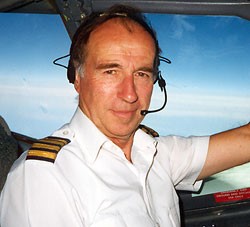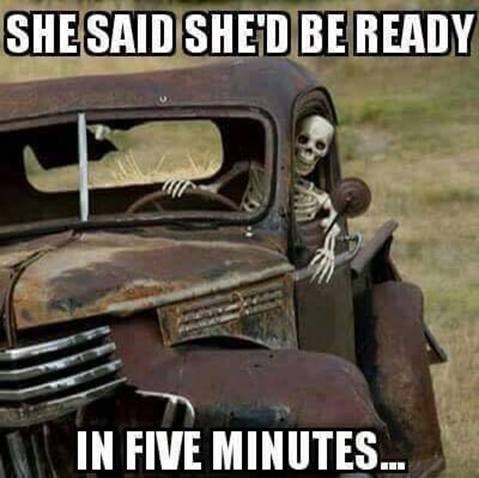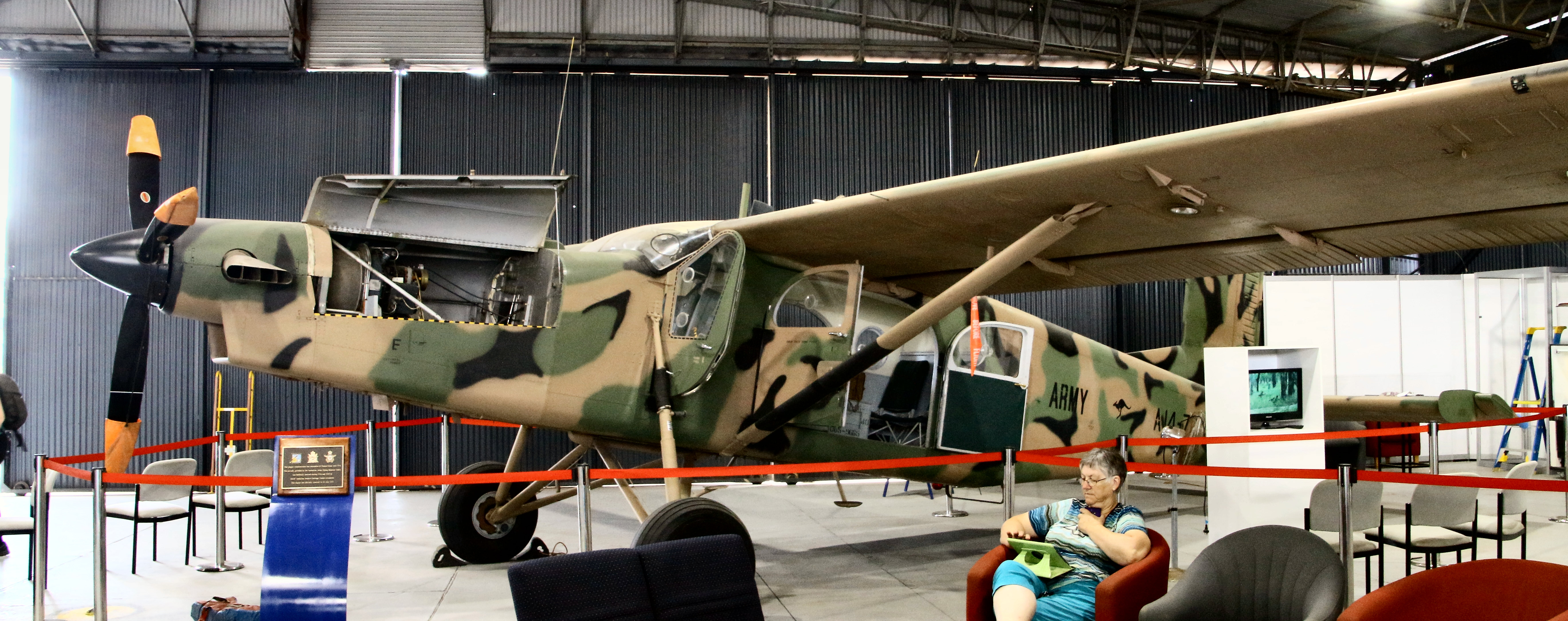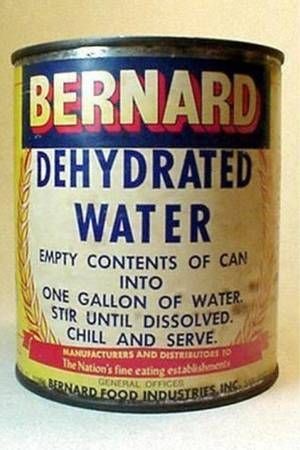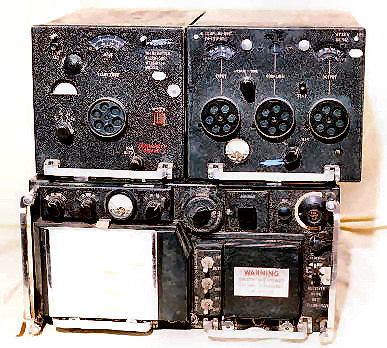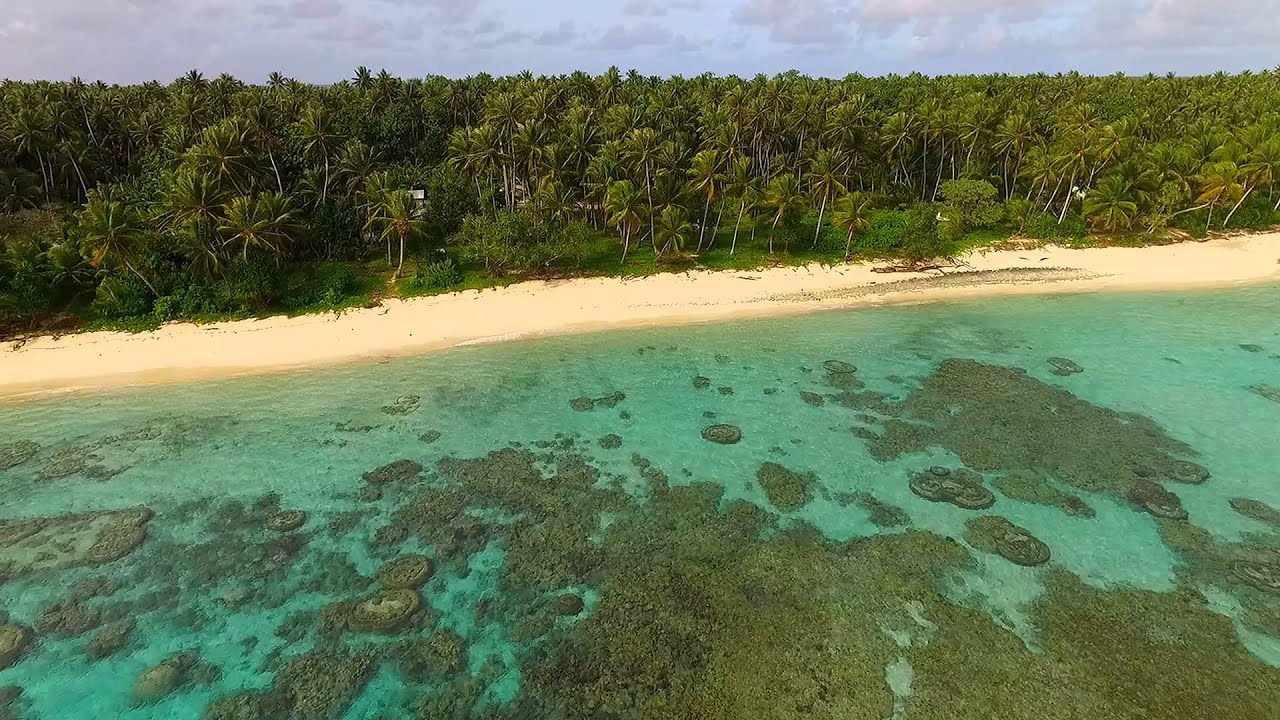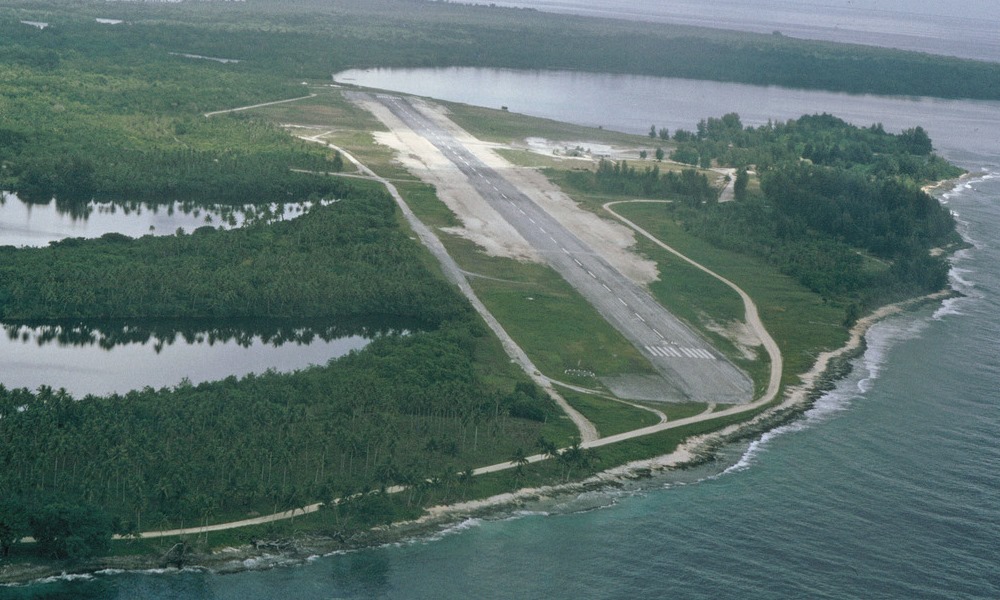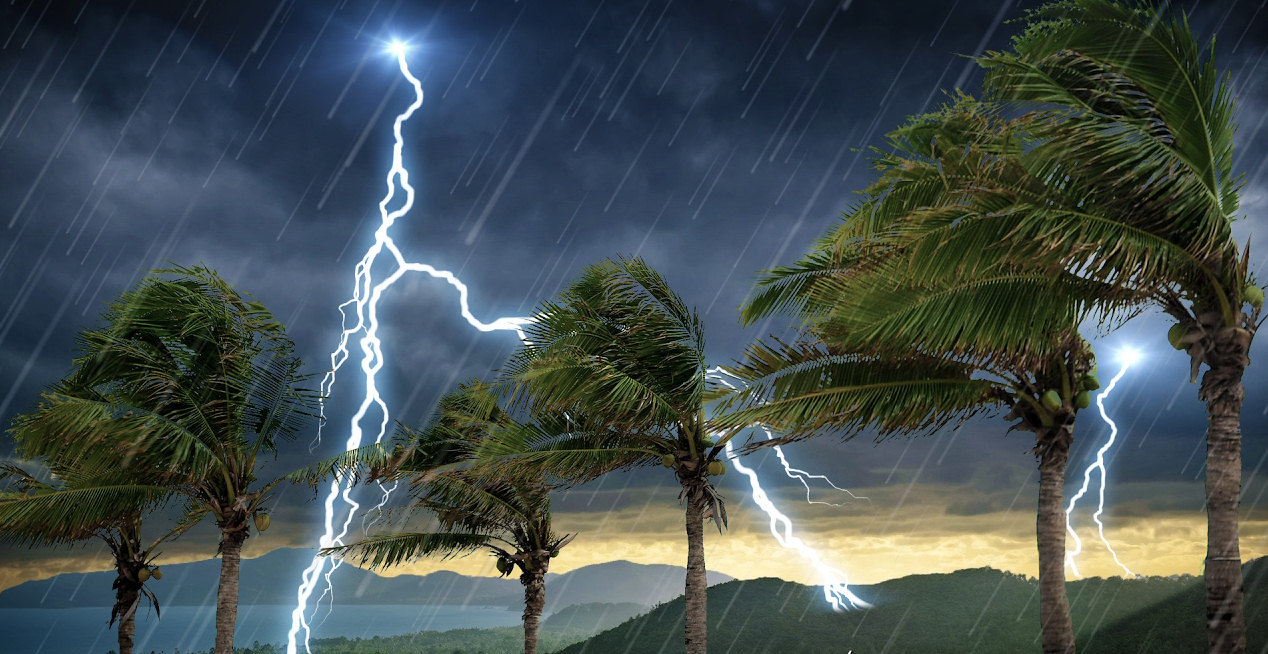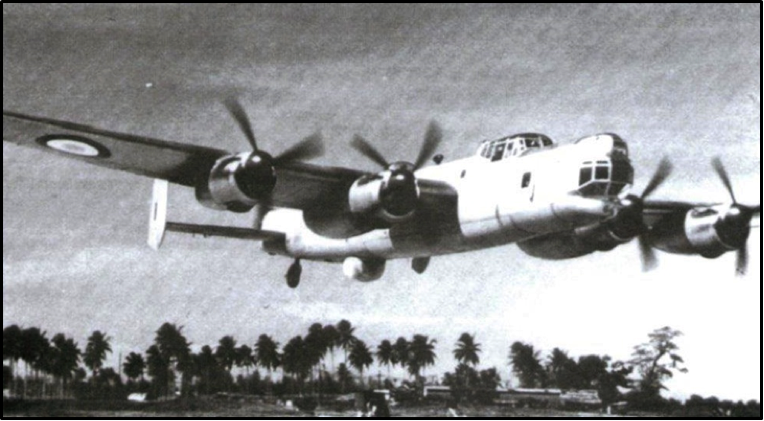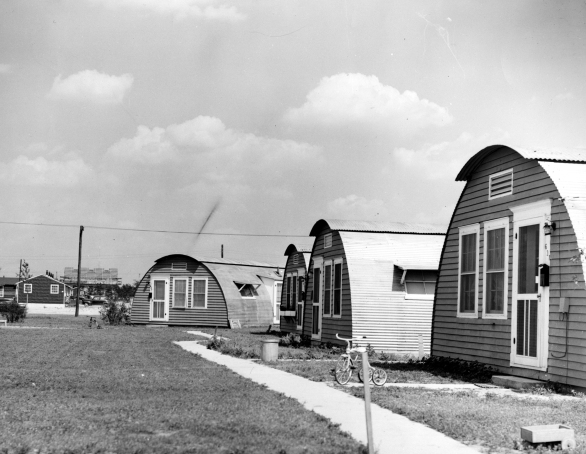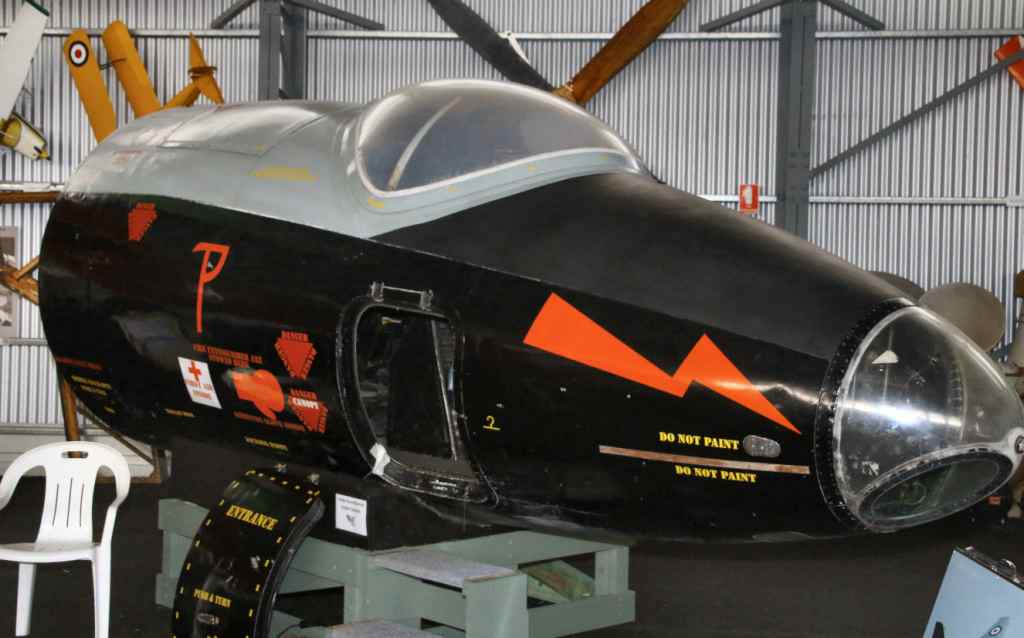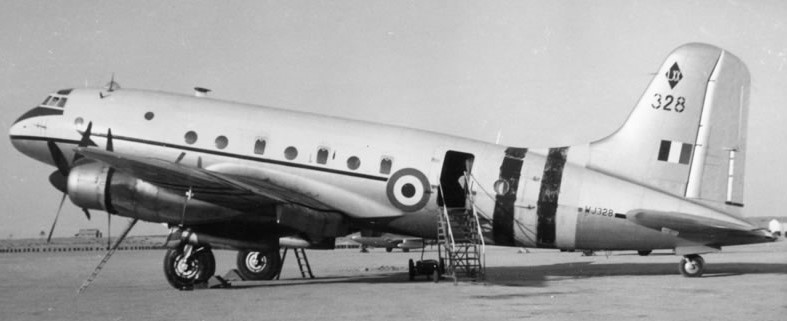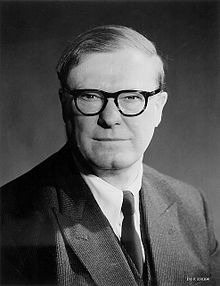|
|
||
|
||
|
Privacy Policy | Editorial Policy | Profit Policy | Join the Association | List of Members | Contact us | Index | Links |
||
|
Back Go to page: 1 2 3 4 5 6 7 8 9 10 11 12 13 14 15 16 17 18 19 20 Forward
|
||
|
John Laming Aircraft and other stuff. |
||
|
Contents:
Pilatus Porter in New Hebrides RAF Canberras lost in the Pacific
|
||
|
The Republic of Nauru, once rich in phosphates, is a tiny atoll in the Pacific Ocean. At an easy speed, it takes just half an hour to drive around the island, passing battered Land Rovers cruising slowly, with rap and heavy metal music blaring from their speakers. When I was there in the 1970s and 1980s, it was the home of Air Nauru which flew three Boeing 737-200s and two B727-100s and I was a pilot on the B737 fleet.
|
||
|
|
||
|
The island’s airport had a short runway only 5,700ft (1737m) long, with 3Oft (9m) drops into the ocean at each end. With strong westerly winds sending shimmering mists of salt water spray from nearby big rollers, landings on Nauru are not for the inexperienced. One day, I was waiting to fly a leg to Hong Kong. The handwritten flight plan in my navigation bag showed refuelling stops at Ponape, Guam, Saipan and Manila. The sound of an approaching jet was heard, and all eyes turned to watch an incoming B737 appearing on a close left base behind the phosphate pinnacles on Topside (the mining area). A police motor-cycle rider halted traffic on the coast road crossing just feet away from the threshold of Runway 12, and seconds later, a well-judged touch-down sent up a blue puff of smoke from the tyres, accompanied by the shattering roar of full reverse thrust. Everyone craned their necks to see if the B737 would pull up in time, and there is visible relief when they see it has stopped with feet to spare.
Watching the Boeings take off and land is a national pastime on Nauru, there being little else to do by way of recreation. After turning at full lock on the nosewheel, the aircraft backtracked towards the airport terminal — a scene repeated each day as Air Nauru Boeings passed through the Nauru Island hub. The public address system at the terminal announced that Air Nauru Flight 385 from Tarawa had landed — no mention of the aircraft being two hours late on schedule. Officialdom does not apologise on Nauru and in any case, one hour late is considered an everyday occurrence for this small Pacific operator — half a day late seldom raised eyebrows.
As an aside, and on the subject of eyebrows, these are used in many Pacific islands to signify a casual greeting or simply when talking to someone. Although most Nauruans speak good English, they choose words carefully, and sometimes acknowledge not by nodding, but by an upward twitch of bushy eyebrows.
|
||
|
|
||
|
A pilot was in the cockpit of his B737 on the tarmac with a new First Officer.
The control tower at Nauru is situated close to the apron, pilot and tower
operator can see each other. The First Officer called ATC to obtain a radio
check, but received no reply, so he called again. The captain waved at the tower
operator, w
As people speculated upon the reason for arrival of the late arrival of the flight from Tarawa, the policeman on his equally huge Honda Goldwing, had left the road at the end of way and, missing a wandering pig by inches, scorched down the half-mile of road skirting the runway just in time traffic crossing the taxiway into the tarmac area. Carefully negotiating the road crossing, the pilots of the B737 waved a ‘thank you’ to the policeman, who flashed him a broad recognition. He then made a tight one eighty on the tarmac and as the sound from the great turbines wound down, chocks were inserted under the wheels and the hot brakes were released.
|
||
|
|
||
|
|
||
|
The cabin cleaners, a motley crew of large and expressionless ladies, walked slowly towards the B737, their rubber-thonged sandals thwacking on the hot tarmac. No one hurries on Nauru. Reaching the shade of the left wing, they watched as the passengers stepped gingerly down the steep air-stairs. Large, colourful bags masquerading as hand luggage were shouldered from the cabin, it was almost possible to see the squat oleo struts of the B737 expanding in relief as it lost the combined weight of 80 passengers, with bulging suitcases, and boxes of cargo.
Finally the two pilots appeared at the door way, navigation bags in hand. The
captain looked as if he’d been in a brawl with the Devil himself, his face
showing the signs of severe bruising. He was not in his usual amiable mood as he
explained the cause of the delay on the trip from Tarawa. Tarawa lies 378 miles
(610km) northeast of Nauru and was the scene of bitter fighting between Japanese
and American forces in 1943. Known then as the Gilbert Islands, this area became
the Republic of Kiribati in 1979 and was one of Air Nauru’s early destinations
when it received its first Fokker F28
|
||
|
|
||
|
Some of the wrecked and dumped aircraft around the islands were interesting. This is a French Navy Avro Lancaster which ground looped on landing at Wallis Island around 1957 and was left there. It was later transported to the museum at Le Bourget, Paris.
|
||
|
After the airstrip had been cleared of stray dogs and pigs by the sole fire-tender, the B737 landed. (Earlier, a visiting New Zealand inspection team had discovered that the fire vehicle carried less than half a tank of water. Questioned, the local fire chief explained gravely that with less water in the tank, the vehicle could travel faster and thus arrive at the scene of a crash more quickly.)
After stopping outside the open-air terminal, the pilot cut the engines and
directed the senior female flight attendant to lower the air-stairs. Stepping
carefully down to lock the handrails, she was astonished to see one of the
waiting officials break away from the group and, yelling loudly, rush up the
stairs towards her. He knocked her sideways and burst into the cockpit, where
the two pilots, still strapped in, were completing their final cockpit checks.
Both turned around at the intrusion, only to be attacked by flying fists and
unintelligible shouting in the local language of Gilbertese
A typical Air Nauru crew awaits its passengers in 1980
After an almighty brawl, the intruder was unceremoniously thrown down the stairs on to the tarmac where, as a last gesture of defiance, he picked up some coral and hurled it back up the stairs. At this point, the police stepped in and led him away. After checking to make sure the flight attendant was not hurt, the dazed captain picked up a microphone and, with a commendable sense of humour, apologised to the amazed passengers, assuring them that this was not the normal standard of Air Nauru’s in-flight entertainment. Nevertheless, he said, it was an international incident and the flight would be delayed until things were sorted out with the local police.
To add insult to injury, spraying the cabin went ahead in spite of the fact that the door had been open all this time. The battered chief pilot demanded to see the Police Commissioner, who eventually arrived in a rusty Land Rover. After the intruder was inter-viewed, the Commissioner offered the following explanation. Yes, the man was known for his strange behaviour but apart from chasing a local pilot with a knife the previous year, he was considered harmless. He had been allowed to wander around the tarmac as long as he didn’t get in the way, though latterly he had shown a keen interest in the arrival and departure of the twice-weekly Air Nauru flight. He lived in a thatched hut among the coconut trees near the runway threshold and even played football on the runway with other locals when no aircraft were due. When police asked him the reason for his attack on the crew, he pointed out that he was merely defending his property.
Asked to clarify that statement, he told the Police Commissioner that three times in as many weeks a departing B737 had blown the roof off his hut with its jet blast as it lined up for departure. He felt that enough was enough and that the time had come to sort out the pilot of the Boeing. As far as he was concerned, honour was now satisfied, and he was quite happy to accept the consequences of his actions. To the locals, his explanation was perfectly logical and he was set free.
To prevent further problems, the aircraft captain graciously undertook to publish an amendment to the operations manual that for departures, all taxi turns were to be made to the left, thus minimising the risk of jet blast damaging nearby grass houses.
During the years I flew for Air Nauru, there was no shortage of similar stories. Crews criss-crossing the Central and Western Pacific and making stop-overs at various islands would meet at the bar and exchange gossip about the latest adventure. A few months after the Tarawa punch-up, a B727 departed Nauru for Kagoshima in Japan via Guam. On this occasion there were no passengers, a common occurrence on Japan flights. On board were three Australian cockpit crew and four female flight attendants. Of the latter, one was Japanese, another from the Solomon Islands and the other two Nauru nationals. Shortly after take-off, the seat-belts sign was turned off and the flight engineer ordered coffee for the three crew. The Japanese air hostess, relaxing in first class with no passengers to worry about, rang down the order to the Nauruan girls, who had already settled down to sleep on empty seats at the rear of the aircraft. There had been an island party the night before and they had hangovers.
Nauruan nationals working for the Government airline could break the rules and rarely get sacked. Not so for contract expatriate staff, who could be dismissed on the spot. Consequently, when one of the Nauruan girls told the Japanese flight attendant to make the coffee herself, it was done with the knowledge that her insubordination would go unchecked. She was wrong on this occasion. The Japanese girl, an exponent of the martial art tae-kwon-do, stalked to the rear of the B727, shook the Nauruan by the shoulder and ordered her to get off her backside and prepare coffee. Nauruans are normally slow to anger, except when suffering from hangovers. Punches were thrown, hair pulled and a full-on brawl was under way by the time a junior attendant woke up and frantically rang the cockpit crew to come down and stop the fighting.
The Flight Engineer picked up the phone and initially thought she was joking as he knew there were no passengers aboard. The Captain handed over control to the First Officer and went to investigate. Finding a fight on his hands, he stepped in to separate the combatants. As he said later, there was no way these two were going to kiss and make up, and the thought of further action enroute to Japan convinced him that drastic measures were needed. He told the Flight Engineer to dump fuel and the aircraft returned to land at Nauru. Safely on the ground, the flight was delayed until two more cabin crew were produced and the warring pair had been sent to the local hospital to be patched up. The problem eventually solved, a late Air Nauru Flight 821 was again dispatched to Japan with a crew of seven and nil passengers.
Although these stories might be considered a bit of a laugh at the expense of Air Nauru, the airline has nevertheless had an unblemished safety record since it started out in 1973 with one F28. While the pilots were mainly Australian, in a nice touch by the President of Nauru, flight attendants were recruited from each of the destinations the airline served. Maintenance was of the highest standard money could buy and was undertaken in Australia, New Zealand or Hong Kong. A ground engineer was carried on all flights, a policy which ensured excellent serviceability of the aircraft enroute.
In 1968, Nauru won its independence and soon became extremely wealthy due to its phosphate exports. Chartered aircraft flew skilled labour and essential services to the island, until in 1973 the Nauru Government decided to operate its own air services, using two F28s purchased in Australia. The government financial centre was Melbourne, and the airline’s primary route was Melbourne to Nauru with New Caledonia as a re-fuelling stop half-way. With millions of phosphate dollars available to run the airline, the President of Nauru now began to fulfil his dream of uniting the Pacific peoples with air links that would eventually serve destinations as far away as Singapore and Honolulu and many island countries in between.
The route structure was a travel agent’s dream, including services to Hong Kong, Kagoshima, Taipei, Okinawa, Singapore, Guam, Saipan, Palau, Manus Island, Truk, Ponape, Kosrae, Majuro, Tarawa, Honolulu, Guadalcanal, Vanuatu, New Caledonia, Western and American Samoa, Fiji, Tonga, Wallis Island, Niue, Rarotonga, Auckland, Melbourne, Sydney, Brisbane and Christmas Island.
|
||
|
|
||
|
The arrival of a flight always attracted a large number of well-wishes and relatives in Western Samoa.
|
||
|
Few travel agents had ever heard of Air Nauru in those early years. The President saw no need to advertise the airline and indeed the first commercial manager to be hired lasted just six months before he was dismissed. An outspoken Irishman, he lost his job for daring to tell the President that the operation was losing millions of dollars due to lack of passengers and freight through all destinations and that serious advertising was needed. As far as the President was concerned, if you hadn’t heard of Air Nauru, you didn’t deserve to fly on it. When they stayed at the prestigious Hilton Hotel in Guam, its pilots would meet up with the highly-paid crews of the then-famous Pan American Airways. When we were asked which airline we flew for, our reply “Air Nauru” invariably invoked a quizzical look and an incredulous “Air Who?” The average load factor throughout the network was around 20%, the airline being heavily subsidised by the island’s Government, which regarded the operation as an essential service.
However, the good life which followed the huge earnings from phosphate sales eventually resulted in the population of Nauru starting to suffer high rates of diabetes and heart disease, and a good proportion of the passengers carried from Nauru to Australia were locals seeking urgent medical treatment. With almost half of the gross national product at that time, (1976-86) 100 million Australian dollars per year, going into the airline, health services, education and other essential services on the island were being given low priority in government spending.
The operations of Air Nauru, along with poor economic decisions from succeeding governments, would one day send the tiny island broke. For the airline’s pilots, flying for Air Nauru was one of the best jobs in the world.
|
||
|
|
||
|
Although salaries were well below those of the union-dominated Australian
airlines, the exotic locations, well-maintained modern jets and the company of
the delightful island flight attendants amply made up for the lack of take-home
dollars. Passengers who flew the Pacific routes with Air Nauru often included
school-age children whose parents worked on Tarawa and Nauru, most of whom
travelled unaccompanied from Hong Kong and England
A large number of buildings and gun emplacements from WW2 can still be seen on the islands.
The airline carried businessmen selling anything from sewing machines to stamps, and often there would be Pacific islanders visiting long-lost cousins on remote atolls. Occasionally one saw priests and nuns returning home to Ireland after years of missionary work in far-away places with strange-sounding names. From Hong Kong harbour came Gilbertese seamen paid off from their ships, going home to rejoin wives and children they may not have seen for several years. There were adventurers and tanned Lotharios, accompanied by beautiful young girls, travelling to Guam and Palau to pick up or deliver a rich man’s yacht. Diving club members eager to visit the underwater marvel of Truk Lagoon to snorkel on sunken Japanese warships from the Pacific War. And who can forget the polite bowing of so many young Japanese honey-mooners as they boarded the Air Nauru flight from Kagoshima for a week of sand and sun on Guam or Saipan.
Japanese tourists were always made welcome, despite the fact that both islands had been the scenes of fierce battles between US and Japanese forces during the war in the Pacific.
In 1988, Air Nauru pilots went on strike for better pay and safety conditions. The President of Nauru, realising too late that the airline’s losses were crippling the island’s economy, sold the two B727s. This had left three B737s at the time of the strike, the first to hit the Government on home ground. The President reacted angrily by sacking all but a handful of pilots. His actions alarmed the civil aviation authorities of USA, New Zealand and Australia and led to the suspension of Air Nauru’s Air Operators Certificate. Undeterred, he quickly recruited volunteer pilots from Indian Airlines to replace the sacked Australians, and for six months the B737s flew under a Private’ category, with passengers travelling free of charge. Before long, Nauruan passengers flying to Australia for medical treatment were showing growing unease about the competency of foreign pilots, and their concern led the Government to reconsider its decision about not recruiting pilots from Australia.
A heavy landing on Nauru by an Indian pilot had succeeded in chipping one of the President’s daughter’s teeth. Enough said —“Let’s get the Aussies back” was the view of the Nauruan population which, in spite of the earlier strike, still had a fondness for the Australian pilots. In 1989 there was a major confrontation between the Australian Government and pilots from the two main domestic airlines, which resulted in over 1,000 experienced pilots finding themselves out of work. Air Nauru was inundated with job applications, and when the airline resumed operations with just two B737s, its pilots were predominately from Australian airlines. However, the island’s phosphate reserves were fast running out and by 1994 Air Nauru was down to one aircraft, a B737-400, registered in Australia and maintained by Qantas.
The once incredibly wealthy island of Nauru is suffering a severe financial crisis, its phosphate deposits, the primary source of its income, having almost gone. Once-profitable investments have been sold in order to stave off critical short ages of food and supplies, leaving it almost totally dependent on Australia for aid. A long-term legal battle over lease payments on the remaining B737 threatens the long-term viability of Air Nauru. Just a few destinations are still being flown, the rest are now just a memory in the log-books of the airline’s former pilots. Today you can buy a ticket to Brisbane, Nauru, Guadalcanal, Tarawa, Fiji, Majuro and Melbourne, and that’s about all. It’s a far cry from the days when the Boeings of Air Nauru roamed the Pacific skies from Tarawa to Taipei and islands in between.
|
||
|
|
||
|
|
||
|
In a recent issue we had a pic of a Pilatus Porter that is on display at the Museum at Amberley. We said:
“This particular aircraft arrived at the 1st Aviation Regiment, which was situated at Amberley, in May 1971. It saw service overseas in Papua New Guinea and Vanuatu. All the Army’s Porter aircraft were delivered to Amberley and were operated from there until the move to Oakey in 1973. RAAF personnel were posted to 16 ALA and 1 Aviation Regiment and were initially involved in servicing the aircraft and training Army personnel.”
A mate who lives in Canberra and who normally tells whopping lies – but this time I believe him, saw the article and wrote. He said:
|
||
|
“Mate,
My fading memory tells me that that Porter was one of two Army ones that came to the then New Hebrides around September of 1980 during the ‘Bow and Arrow Rebellion” led by Jimmy Stevens. One of the pilots was named Groves I think but I can’t remember the name of the other one - I think one of them was killed later on at Oakey. Apparently, they set some sort of record on the way to Port Vila for the longest ‘over-the-water’ flights by that type of aircraft coming from Oakey via the Solomons.
When in Vila they would take off for the island of Santo late afternoon and scare the life out of the rebels on Santo by doing some low-level stunts up and down the main street of Luganville (the widest uninhabited main street of any town in the World) while looking for the source of a rebel radio transmitter. Lying on their faces on the floor of the Porters were a couple of strange looking Australian civilians from Canberra with some sort of ‘funny’ equipment. A day or two before their departure the boys took the entire Australian-based staff (there were two of us at the time with two support staff and a blow-in from Canberra) for a joy ride around Vila and environs. Unfortunately for us some senior chappies in Defence and Foreign Affairs were trying to contact us at the same time. Suffice to say we were reminded of what might have happened to Australia’s representation were there to have been some sort of accident.
I tell you what though, not only could those two blokes fly but they scared us as much as they did the locals. They also were very active on the social scene but I cannot reveal further as some of the participants are still alive.
I also remember a bloke called Lang Kidby who came down from Moresby (also in DC’3’s and a couple of Nomads) with the PIR (among quite a few other Air Force and Army blokes in support roles including a Tasmanian who was their Commanding officer) and they very quickly put a stop to the rebellion nonsense. I remember getting permission from Vanuatu’s Prime Minister (and Minister of a good protestant religion) Walter Lini for Kidby to keep a silver-plated .45 Revolver that had been taken from a rebel - I remember Kidby because apart from being a good bloke I believe he flew that replica Vickers Vimy from England to Australia a few years back?
I also recall you telephoning us in Vila a few times no doubt to make sure that all was well and that I was attending Mass regularly during those dark and threatening times.”
Regards – Gazza.
|
||
|
|
||
|
|
||
|
Gazza also says:
“The story about Air Nauru reminds of one late afternoon in Port Vila I was standing on the tarmac (more likely beside the Bar) with a Kiwi named Ian McIntyre who was the local representative of Air Nauru. We were waiting for an Air Nauru 737 with some sort of medical evacuation capsule on board to come from Nauru to take someone to Australia for medical treatment. We waited and waited and some hours after it was due to arrive the Kiwi got a telephone call from Nauru to say that the President (or his wife) had commandeered the 737 for a flight to Hong Kong to do some shopping - we normally relied on the RAAF out of Richmond to provide emergency medical evacuations and I can tell you that after this incident we never went commercial again while I was still there.
They tell me that all medical evacuations now are done by private firms but back in the 80’s the RAAF was our best personal health insurance policy. It also got us a lot of kudos as we could use it for not only our Staff but for anyone else on a needs basis regardless of nationality.”
|
||
|
|
||
|
|
||
|
RAF Canberra incidents 1954. John Laming
A detachment of the four Canberras, under detachment Flt 1323 deployed to the Pacific under Operation Bagpipes/Likewise, to cover the CASTLE series of US hydrogen bomb tests in the south Pacific scheduled for the Spring of 1954. In January 1954 the Flight received a further two Canberras for a second commitment known as Operation Dogstar. This task was particle sampling of the radio-active clouds produced by the US hydrogen bombs at the invitation of the US military. Both the Likewise and Dogstar Canberras were fitted with extra navigation and radio equipment (twin TR1936 VHF sets and a STR18B HF set) for overseas flying during the January.
On 11 February two officers and five men left RAF Base Wyton for Darwin in support of Operation Bagpipes/Likewise followed on 14 February by the ground party for Operation Dogstar comprising five officers and 14 men. The two Dogstar Canberras followed on the 15 February tracking via Singapore to Darwin. From Darwin the next leg of the journey for the two Dogstar aircraft was to Momote in the Admiralty Islands (to the North of Papua New Guinea), then a long hop across the South Pacific to the US test site at Kwajelein. While flying in loose formation enroute to Kwajelein on 23 February, WH738 drew up alongside WH881 and the pilot gave the “cut throat” signal indicating a loss of radio or electrics, before turning away and descending. Sadly, WH738 and its crew were never seen again, presumably lost after ditching in the Pacific. Such was the importance of Dogstar that one of the Operation Bagpipes/Likewise Canberras, WH697, was then fitted out for particle sampling and dispatched from Wyton as a replacement for WH738 on 28 February.
The replacement Operation Dogstar Canberra, WH697, arrived at Darwin on 4 March and then flew from Darwin to Townsville and enroute experienced navigational problems, which culminated in his following a civil aircraft into Townsville. On landing at Townsville (I saw the landing personally), the nose-wheel shimmied to ninety degrees which was quite spectacular.
It took several days to get spare parts and the aircraft was roped off and under guard on the tarmac. It later took off for Momote and began the Momote/Kwajelein leg of the journey a week later. Problems were encountered with the Radio Compass during the flight. Apparently when enroute to Eniwetok there were a lot of cumulonimbus clouds about and the radio compass usually pointed to the biggest.
When the Canberra descended on flight plan ETA the navigator was unable to pick up the Kwajalein beacon. Worse still, no land was visible. A square search was then commenced and, just as the possibility of ditching seemed likely, an island was spotted. A successful forced landing was made on the beach in shallow water, happily without injury to the crew. The island was part of the Ailinglaplap atoll, about 115 miles south of the Kwajelein.
The crew remained as guests of the islanders for several days until a US amphibian search and rescue aircraft spotted the beached Canberra and landed to retrieve them. Islanders from Ailinglaplap atoll had sailed to Kwajalien Island and notfied the Americans that the plane was down on their beach.
WH697 was damaged beyond repair and so, after removal of the engines, the airframe was towed out to sea and sunk. Unfortunately the Canberra floated rather better than expected and refused to sink, even when subjected to gunfire. Finally the salvage vessel resorted to ramming and WH697 sank beneath the waves into 1,500 ft of water, safely beyond all recovery.
I was involved with the extensive search for aircraft WH738 a week or so earlier. We had several Long Nose Lincolns Mk 31's searching out to sea from Momote, Kavieng and New Britain. I did 70 hours in eight days including positioning legs from Townsville to Momote. At one stage my Lincoln lost an engine 700 miles out to sea, but we continued the search on three engines before returning to Momote. We saw several old Japanese aircraft that had forced landed on various beaches and one very rusty and deadly floating mine with horns and all.
At Momote we were told that the missing Canberra had struck radio or electrical problems on its arrival at Momote, but that the pilot elected to press on regardless of the defects. There was no advance support for the RAF Canberra's which seemed incredibly poor planning by the RAF.
When WH 697 also went missing, we could hardly believe our ears. Like the first missing Canberra, we were awoken at 0200 from our beds in the Sergeants Mess at Townsville and briefed to get going asap for Momote all over again.
We thought that the first aircraft must have flown into a thunderstorm at high altitude - they abounded in those waters or should I say skies! But the account of two Canberra's in formation has come as a complete surprise to me after all these years. We were never briefed that there were two Canberra's involved when Garfield disappeared. Such was the secrecy of the operation.
Shuffling through some of my old writings during a compulsory wife directed clean-up of stuff in the shed, I found the following:
A Canberra is missing.
In early 1954 two RAF Canberra bombers were to fly from Australia to Kwajelein Atoll in the Marshall Islands. The purpose of the flights was shrouded in secrecy. At the time the Americans were using the remote atolls of the Marshall Islands for Atomic Bomb testing. The most well known of these was Bikini Atoll. The first Canberra simply disappeared. In all probability it went down in a severe thunderstorm. The second Canberra also ran into a thunderstorm from which it survived, only to force land on a remote Pacific atoll. Neither aircraft was fitted with an automatic pilot, which meant that pilots had to hand-fly the aircraft for several hours at high altitudes.
The inter-tropical front weather in the Central Pacific region is characterised by violent thunderstorms topping 60,000ft. In those days, with no weather radar available, aircraft around the world were known to have been lost after penetrating thunderstorms at night in thick cloud. Despite the undoubted flying skills of RAF pilots at instrument flying, the severe turbulence experienced in thunderstorms could cause the pilot to lose control of the aircraft. Flying as co-pilot on a Lincoln bomber, I was involved in the airborne search for both Canberra bombers. The first one vanished forever.
The second Canberra forced landed in a lagoon and the crew got wet feet. Fifty years later Flight Lieutenant J. Thomas RAF, the pilot of the surviving Canberra, published his story in the British aviation magazine "Fly-Past " under the title "Pacific Splash-Down." His edited tale is reproduced below with my part of the story added.
Pacific splashdown.
The year was 1954 and Winston Churchill was Prime Minister of Great Britain. The British spies Burgess and McLean had defected to Russia along with Fuchs, the atomic scientist, and as a result the Americans were very reluctant to share any new nuclear developments with us. Churchill was aware that a new device (an H-Bomb) was to be detonated and he wanted the UK to be involved, but the US military refused to allow the British to participate. However, Churchill had come to an agreement with President Roosevelt in 1945 that our countries (Great Britain and USA) would share any nuclear development. Though the US thought we were a poor security risk, they were reminded of this agreement and reluctantly decided to let us participate in the experiment. It is probable that only a few members of the Cabinet and even fewer Americans ever knew that the UK would be involved.
At the sharp end, 1323 Flight was formed at the Royal Air Force base at Wyton, near Huntingdon under very tight security. Those of us on the flight were unaware of our true destination or the task to be done. We thought we were going to Woomera in Australia, or to Christmas Island. Early in 1954, myself (then a Flight Lieutenant) and a navigator Flying Officer Chalkie White, were flown by civil aircraft to Darwin where Canberra B2 WH 697 was already located. It had special filters fitted to the wings and in addition to the two 250 gallon wing tanks, an extra 400 gallon tank was installed in the bomb bay. Much later, we discovered that we were to take samples of airborne particles following the H-Bomb tests. We were still unaware of our destination or task. I was given a code-book - all the signals concerning 1323 Flight were known only to me. During the stay in Darwin, extra navigational equipment was installed in the aircraft, although it proved to be useless.
Then I received a signal informing me that F/L Garside and crew were missing. Garside and two crew were flying in Canberra WH 738, also of 1323 Flight, and went missing enroute between Manus Island (Momote) and Kwajelein, off the Marshall Islands, on February 23 1954. Both Manus and Kwajelein had been occupied by Japanese forces during the war. My signal said that I should proceed immediately to Townsville. The first attempt to reach there was aborted after an hour because of electrical failures. A few days later we set out for Townsville again, but after 90 minutes problems developed with our various navigational aids, so we decided to overfly our ETA and descend out to sea. Just at that moment we spotted a civil aircraft some way ahead descending into clouds - it could only be going to Townsville. We came out of cloud at 3000 ft about 20 miles out to sea. On landing at Townsville the nose-wheel of the aircraft turned at right angles to our landing path. It took several days for spare parts to be flown in. Soon after I received another coded message giving our next destination as Momote aerodrome on Manus Island, which was within the Admiralty Islands chain. The flight was uneventful. The visibility was excellent and we waited at Momote for a favourable weather report from the US base at Guam.
At Momote we were informed of our final destination which was Kwajelein. We knew that F/L Garside and his crew had gone missing on this last leg of the journey. We received a favourable weather report and took off on March 11, 1954, for Kwajelein, a trip of approximately 2500 miles.
After about 90 minutes at about 45,000 ft, we ran into an inter-tropical weather front and experienced violent turbulence. We were still in cloud at 50,000ft, then within 30 minutes both No2 and No3 inverters failed. This left me with about 20 minutes of full instruments before we would have to revert to the primary instruments (no artificial horizon). A decision to remain at height or descend had to be made. Descending would mean we would have a fuel shortage, but by staying at height, the heavy turbulence could mean loss of control. We descended and never really came out into the clear but flew at about 100 ft above the water in intermittent rain. By our calculations we had flown through the line of the Marshall Islands which were running north-west to south-east of our flight path. I decided to turn south hoping to touch one of the group of islands - we only had enough fuel to last us about 30 minutes.
Suddenly, palm trees flashed past the wings and we were over an atoll. We circled with flaps and wheels down and landed on the reef in about 8 inches of water and rolled about 500 yards. A few hours later I started the engines and taxied closer to the palm trees. The only damage to the aircraft was to the flaps, caused when the water hit them. Some natives arrived from another island (ours was uninhabited) and during our four days there they were most helpful.
The head man, Tokuni, agreed to send a message by outrigger canoe to the US base at Kwajelein. We also established from Tokuni that we were on Borg Island, or Ayling Laplap, some 75 miles from Kwajelein. During the few days on the atoll, we observed the numerous sharks in and around the lagoons and when the PBY Catalina put down to rescue us, they signalled us to swim out - I think both of us must have broken all Olympic swimming records!I must be the only RAF officer to have shaken the hand of an American Admiral wearing only my underpants!
The story by the surviving Canberra pilot greatly interested me because, as a young sergeant pilot, I flew in several searches for both of the missing aircraft. My unit was No.10 (Maritime Reconnaissance) Squadron of the Royal Australian Air Force, based at Townsville in North Queensland, Australia. We were equipped with Lincoln MK 31 aircraft, known as Long Nose Lincolns. With bomb bay fuel tanks, these aircraft could patrol for 13 hours. We were alerted on the night of 23 February 1954 that a RAF Canberra was missing north of Manus Island enroute to an unspecified destination. Momote airstrip on Manus Island was a remote RAAF base which 10 years previously had been a battleground against Japanese forces in the Pacific campaign. By 0100 local time, I was aboard one of three Lincolns hastily despatched to carry out searches to the north of Momote towards Guam and around the islands of New Britain and New Ireland. The six hour flight took us over Port Moresby, where we are forced to climb to 16000 ft in heavy cloud to get over the Owen Stanley Ranges in New Guinea. I shared the flying with Flight Lieutenant Wally Wearne (a former Lancaster pilot) and Sgt. Bill Fisher the co-pilot of that crew. We were battered by heavy tropical cloud enroute and I felt dizzy due to an oxygen hose fault, which resulted in my experiencing anoxia for much of the flight.
After arriving at Momote, all three Lincolns were refuelled and readied whilst the officers in the crews were briefed on the search area. The non-commissioned officers (NCOs) of each crew were not permitted to attend the briefings due, apparently, to the secret nature of the missing Canberra's mission. This was rather absurd, in that the captain of one crew was an NCO, who had to be briefed second hand by his officer navigator. Certainly none of the search crews were aware that the destination of the Canberra was Kwajalein, although we knew that American search aircraft were covering the Pacific well to the east of Guam. One hour later at 0700, with full fuel and extra crew, our Lincoln A73-67 needed every inch of the 5200 feet length of Momote's coral runway to get airborne. I remember instinctively lifting my backside off the co-pilot's seat as the reef flashed under the aircraft, with the rear gunner remarking over the intercomm at the slipstream ruffling the Pacific swell. There were no take off performance charts in those days, just a matter of full throttle on the four Rolls Royce Merlins and hopefully reach flying speed by the far end! The captain on this trip was Flt.Lt. John Thomas AFC with Sgt Bill Woods as navigator and Sgts Geoff Yule and Keith Cameron as signallers. The search height was 1500 feet and covered the area 200 miles south of Guam and east towards New Ireland.
During the next 10 hours, we encountered the extensive thunderstorm activity and torrential rain associated with the inter-tropic frontal zone. It gave me a sobering insight as to the possible fate of the missing Canberra. With lack of modern day weather radar and no automatic pilot, one did not envy the job of a Canberra pilot, battling violent turbulence and flying blind at 45000 feet. Thirty years later, as a Boeing 737 pilot, I flew on air routes in that area and frequently experienced anxious moments at night, steering around monster storms visible only on radar. I logged over 50 hours flying in the first week. Despite hundreds of search hours being flown by Australian and American aircraft, no trace of the missing Canberra was ever found. Our hopes were raised when various aircraft were spotted in shallow lagoons or on atolls and beaches. These proved to be Japanese fighters and bombers apparently pranged during the war. They were in remarkably good nick, with little obvious damage. On one flight we spotted what we thought was a yellow rubber dinghy floating north east of Rabaul in New Britain. A low inspection pass was made at 50 feet, which revealed that our dinghy was actually a rusted shipping mine, complete with ominous looking horns. Perhaps we were fortunate that is wasn't a magnetic mine, because 30 tons of metal passing a few feet overhead, could conceivably have set it off. On this sortie, the starboard outer engine of our Lincoln began to overheat due to a glycol leak and the propeller was feathered. Engine failures such as this were relatively common, and we continued the last 700 miles on three engines.
After landing we were given a 24 hour break to give the ground-crew time to repair the engine, and for the aircrew to catch up on much needed sleep. The latter was difficult because our sleeping quarters were wartime Quonset huts only 200 yards from the airstrip. There was no privacy with six men to each hut. Lincolns running up engines and taking off, and occasional drunks shambling through made fitful sleep impossible. These metal huts were unbearably hot during the day and night and teeming with mosquitoes. After dark, looking for the outdoor latrines among the trees was an illuminating experience. We carried a torch in case a crocodile from the nearby swamp was lurking. There was, however, other entertainment in the form of an open-air cinema with the screen strung between palm trees - the projector being sited in a wooden hut. Its beam attracted hundreds of moths and mossies. The audience of navy and air force personnel would wolf-whistle at the sight of Esther Williams and Rita Hayworth displaying their bountiful charms and boo at the baddies.
I took the opportunity to explore the cockpits of several Douglas Dauntless dive bombers which had been left behind after the war. It would have taken little effort to make them airworthy and in later years I regretted not having the foresight and finance to transport these aircraft back to Australia. I sometimes wondered who finally got their hands on them. They would be worth a mint now.
We were warned about crocodiles. I didn't see any, but neither did I deliberately go looking for them. Few airmen ventured too far from their quarters at night, just in case. The local pidgin English for crocodile was "puk puk". I recall picking up a new Lincoln crew that had just arrived from Townsville. Our transport driver was a local islander who wore Australian navy uniform. A detachment of naval personnel was based at Lorengau Navy base a few miles from Momote airstrip, and islanders who worked on the base wore appropriate naval attire. As our wartime jeep skirted the crocodile swamp, I briefed the new crew on basic pidgin English. However I had forgotten the local native term "puk-puk," for crocodile. Resorting to rather expressive gestures involving simulated gnashing of teeth and chomping sounds, I asked the driver, "What name you call animal with many teeth (demo of teeth gnashing) and swims in swamp? " (much arm waving imitating swimming croc). "We call them crocodiles, Sir" came the polite reply from our uniformed native driver, and in perfect English! I felt a right twit in front of a bemused Lincoln crew, who laughed at my embarrassment, as did the driver.
Eventually the search was called off and we returned to Townsville. A week or so after our return, another RAF Canberra landed at Townsville. It was immediately roped off and put under armed guard. Rumours abounded that the aircraft had experienced serious radio and navigation problems enroute Darwin to Townsville and that the crew had refused offers of help from our radio technicians. It had also made a spectacular landing at Townsville when the nose-wheel apparently locked off centre, causing violent gyrations. Its destination was unknown, and no one was talking. Several days later, it took off and headed towards Manus Island, 1200 miles north of Townsville. This was the Canberra that eventually forced-landed on Ayling Laplap atoll. At 1800 hours on March 11th, we were told that this aircraft was missing, and that we were to be airborne at midnight for Momote. I was co-pilot to Flt.Lt. Keith Wilson, a former wartime Halifax pilot. It was instrument flying all the way, and we ran smack into the usual embedded thunderstorms guarding the Owen Stanley Ranges of New Guinea. We landed into a beautiful tropical sunrise at 0600.
After refuelling, we were airborne for 8 hours, searching along the Canberra's planned track. Again we found nothing. Later the news came through that the Canberra had been found by the Americans on an atoll south-east of Kwajalein, the American naval base in the Marshall Islands. Once more we headed for home, having no idea of the purpose of the two Canberra missions, their final destinations, or the fate of the crews. Then in 1994, I chanced upon the magazine story by the pilot of one of the missing Canberras. The picture was now complete. In the magazine “Pacific Flyer” dated February 2001, more information came to light with regard to the saga of the missing RAF Canberra bombers. The following story was published in Pacific Flyer and written by then Flight Lieutenant Paul Jessop who was a test pilot at the Aircraft Research and Development Unit (ARDU) based at Laverton. It was titled “The Missing Canberra – Will we ever know the real story”. It starts thus:
In the September issue (Pacific Flyer 2003), there was a story entitled “A Canberra is Missing” by John Laming. Perhaps I can add a bit more information and start some serious investigation about the full story. I chanced to be in Darwin from 5 Feb 54 to 9 Mar 54 (as visitors from ARDU, Laverton, we were guests of the Base). Darwin owned a Wirraway which had suffered a misadventure and been repaired. Being current, I had been invited to test it. However, no sooner were we airborne than we got a call from Darwin tower to the effect that there was a Pom in dire straits, in a Canberra with both generators failed and unable to determine his position. The blokes in the tower, being a smart bunch of cookies, had deduced his approximate location and sent us out to fly towards it. This was either 12th, 24th or 26th February but from the dates given by John Laming, I believe it must have been the 12th.
Short story. We didn’t see anything, but the Pom made landfall and landed at Darwin a bit older and wiser. Enter thirteen twenty-three flight-or 1323 as shown in your article. Now how about this for a coincidence? I picked up the September issue of Pacific Flyer enroute to a symposium in Canberra; while there, I met an ex Pom. In conversation, I discovered that he had been a member of the first RAF Canberra Squadron, so I showed him the article in the “Flyer”. Surprise, surprise! Well what do you know – “Black” Thomas was in the same squadron before he was sent to 1323 flight. The article refers to Flt Lt J. Thomas but to everybody who knew him he was “Black” – so with a navigator named White, they had to be the Black and White minstrel show. His comment about the Thomas story was that Black’s memory must have been influenced by the passage of years. He had a clear recollection of the story which he had been told by Black shortly after the event: (this was also the way I recalled it). He also made some comments regarding the anomalies to which John Laming alluded – nothing really new about this when history is written from memory.
Something which must be added is that Black was an engaging character. He was dark complexioned, bald at an early age and a real “hellraiser”. According to my information, he was known to climb out of the pilot’s seat and have a sleep on the walkaway of the Canberra, leaving the flying to the navigator. He was not the type of bloke to let the facts inhibit a good story. During the time 1323 spent in Darwin, we shared the same hangar- the big wooden framed open truss type where you could drive right through in a Gooneybird (DC3) if you felt so inclined. As we also shared the mess, we got to know the boons of 1323 including Black Thomas and Chalky White, all Whites are known as Chalkey.
In spite of what Black says in his story, they were aware that their job was to fly through the H-bomb clouds and take samples. They disappeared from Darwin before we finished our testing. According to the date shown in your story, Garside disappeared on 23 Feb – presumably it was his Canberra which caused concern over Bathurst Island. When we got back to Laverton on 11th March, we found that 1323 had made themselves at home. From John Laming’s account, this was the day when Black and White were reported missing. Bear in mind that because of all the secrecy, we didn’t know any of this at the time. At some stage – it must have been later – we were in the bar having the usual post-fright briefings and doing tomorrow’s flight planning, when a couple of scruffy characters entered the Mess through the back doors – the big glass wall facing south – dressed only in khaki shirts, shorts and footwear. Definitely not mess dress. No evidence of rank or even nationality. Thomas and White – no less. As I knew them from the previous encounter at Darwin, I had to perform the essential introductions and then we got down to the serious business of the evening; ie. To explain their presence and state of mess undress. So at this stage, I got it straight from the horses mouth, as it were.
The immediate response was that their gear was still in the back hatch of the Canberra which was about 20 feet under water. This explanation was followed by their excuse for it being under water. Black explained that their best-laid plans had gone stray, but they had been fortunate to observe “an island with a beach that looked good enough to land on”. So he did just that - wheels down – no less. They were Poms, you see, so it didn’t occur to them that there could be water above the beach – you can’t see through water in UK land! By way of explanation, I have to say that because of his comment about their gear being behind the back hatch (and therefore inaccessible because of the depth of water), and Black’s reference to 20 feet of water, I did not then see any reason to enquire more specifically about the depth. I do recall asking about how they got out of the aircraft. My recollection was that they blew the hatch – but don’t ask me to swear on that one. (Normal entry to and exit from the Canberra was via a door located on the starboard side, the hinge-line being roughly half way up the nose section. The door opened outwards. Therefore, if immersed, it would be difficult or impossible to open. The pilot could jettison his heavy Perspex canopy by firing explosive bolts and the navigator could similarly dispose of a panel of the airframe above his head.
Some 50 years later, I detect some discrepancies between the story that Black told then and what appears in the Laming synopsis, eg. took off on March 11th 1954 for Kwajalein, a trip of 2500 miles. Interesting, what? The B2 Canberra with full fuel, 2x250 gallon wing tanks and a 500 gallon ferry tank in the bomb bay gave you a marginal still-air range of just over 2000 miles. Within 30 minutes, both No2 and No 3 inverters failed (how many did he have, and what did he use them for) – did he mean generators? –we descended and never came out in the clear but flew about 100 ft above the water in intermittent rain. We circled with flaps and wheels down and landed on the reef in about 8 inches of water and rolled about 500 yards. A few hours later, I started the engines and taxied closer to the palm trees.
The story he told us at the time was that they were lost and running out of fuel. As he said at the time “I saw an island with a beach and decided to land on the beach with the wheels down (that was not the recommended procedure). It was only after we touched down that I found there was 20 feet of water over the beach. All our gear was in the back and there was no way we could get down to get the hatch open, so we were stuck with what we were wearing. (the back hatch of the Canberra was under the rear fuselage aft of the bomb bay).
When they arrived at Laverton, they still had only what someone had lent them. The other statement which seems congruous reads – “we were flown by civil aircraft to Darwin where Canberra WH697 was already located – during the stay in Darwin, extra navigational equipment was installed in the aircraft, although it proved useless.
What is the full story? It would be interesting to know the real story of 1323 flight, but it is doubtful if a factual account could be written. The cloak of secrecy which existed at the time meant that little was divulged for posterity. Hindsight would seem to indicate that the operation was a disaster in both concept and implementation.
Questions which come to mind, are…
1323 was supported by at least one Hastings to carry maintenance staff and equipment Why did the unit set up shop at Laverton which was about as far away from the scene of operations as they could get? It stayed at Laverton long enough for one of the members to marry a RAAF Nursing Sister.
We, (the RAAF) were aware, as the result of the Last Great Air Race (London to Christchurch in October 1953) that there were serious problems with “generators”. The Canberra, being the first aircraft to operate for long periods above 40,000 ft, encountered accelerated wear of the generator brushes not previously experienced. In the tropics, this appeared to be aggravated. The Canberra, being an English Electric aeroplane, used electrics for doing almost everything. If a generator packed it in, it got your attention. If the generators on both engines failed, you had to get by on battery power, which didn’t last long. The electrics powered your instruments, communications, fuel pumps and transfer, trim, undercarriage and flap operation, engine re-start and no doubt a few other unimportant things. Therefore, if the focus of 1323 operations was the Marshall Islands in Micronesia, why did they come to Australia at all? Why not go from Changi (Singapore) direct to Guam or wherever – or via Honkers where they could get RAF support.
Certainly, neither Darwin, Townsville, or Momote either knew about or was able to support Canberra operations at that time. Why go Singapore – Darwin – Townsville- Momote- Guam, to get to Kwajalein? Hardly the most economical route, and again – what were they doing at Laverton? (apart from playing silly buggers in the Mess?)
Seriously; on the navigation side:
Weather in Europe was/is such that it is normal to become lost as you leave the circuit. It was therefore normal, at the time of which we speak, to call for a bearing to get back to base. (This was a source of soul-searching among the Australians, who liked to maintain their independence).
On the other hand, the Poms expected to be under continuous surveillance. This just did not exist in Australia or the Pacific. The Yanks had a long range navigation system called Loran, but this did not extend as far as Australia or the islands to our north. Thus the comment by Thomas “during the stay in Darwin, extra navigational equipment was installed in the aircraft, although it proved to be useless”, has particular relevance to the inadequacy of preparations by the Poms. (navigation in Australia was taught on the basis of survival with what you could glean by observation, from whatever sources).
There was at this time considerable dissension about disclosure of information; for brief periods the Australians were on the favoured list with the yanks and at other times, it was the Poms. The Australians had provided range facilities for the Poms, so were subject to scrutiny by both the Poms and the Yanks. If that was not enough, the civilian contractors who were developing weapons systems on the basis of information given to them by the armed services, derived either by intelligence obtained from the enemy or research by government departments, sought to secure their positions by classifying all their work as “Secret”. Let us therefore suppose that at the time in question, the Poms were out of favour, but wanted to get some detailed information about the Yank H-bomb tests. The Australians had accumulated some experience by flying through the Pommy A-bomb tests in the Monte Bellos in late 1952, and the later bangs at Maralinga in late 1953. So if the Poms could appear from Australia doing scientific investigation of H-bomb clouds, they could pass as Australians and hence avoid whatever restriction Congress had imposed on disclosure to the Poms. Just a thought. Does somebody have a better idea?
In 1946 Britain was excluded from cooperating with the states on any nuclear weapons development by the Mc Mahon Act, so proceed alone. Come 1950, the US was desperate to know the extent of Soviet nuclear weapon development in particular their manufacturing capacity. To this end they started air sampling for Krypton 85 which is was thought to be only present in the atmosphere as a result of nuclear weapons production (incorrect as some comes from cosmic radiation - this was a discovery of the program) The US invited the U.K. to help with Krypton 85 sampling so two Canberra’s where converted and so 1323 Flight was born. The sampling fit consisted of a high-pressure pump, feed from bleed air taken off an engine compressor and a single gas bottle in the bay.
When the UK embarked on the H Bomb development it was well behind (William Penny’s first meeting having been instructed to develop the H Bomb, asked “has anyone got any idea’s “). However, by exploiting the joint Kr 85 sampling the U.K. was able express an interest in sampling the Castle H Bomb tests but didn’t expect a favourable response. Samples of the American tests would provide a unique and incredibly valuable insight into the device tested. Much to the surprise of all concerned a request for Kr 85 sampling at Castle came through with only six weeks to prepare. The two Canberra’s of 1323 flight were flown to Warton where hurried modifications were undertaken to prepare them for the vast distances and high altitude radioactive sampling;- an ultra long range fuel tank installed in the bomb bay, conversion from Avtur to Avtag, Radio compass navigation equipment and a maximum size filter in the cabin air pressurisation system.
There was no time for flight testing, so the schedule had the testing being done on the outbound trip. It didn’t go well with multiple problems with all the modifications;-
Add into this the necessity to transit tropical convergence thunderstorms, high accuracy navigation or bust, limited SAR, almost zero training with the new nav equipment, it was extremely high risk flying - one aircraft lost with its crew, its replacement marooned on a beach, but one Aircraft did make it to the test. The look-see this provided into the state of the art H Bomb work gave Britain’s own effort a boost of enormous value.
|
||
|
|
||
|
|
||
|
|
||
|
|
||
|
|

